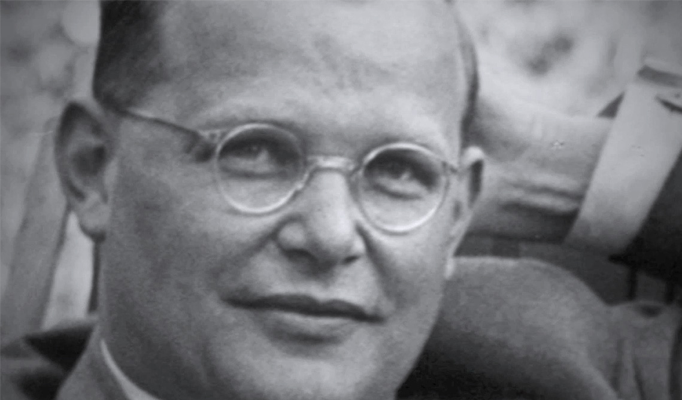
Dietrich Bonhoeffer was a man on mission, a bright spot in the very dark time of World War II.
Coming from a highly educated, aristocratic family, Bonhoeffer shocked his family by deciding to become a pastor. He was supposed to become a psychiatrist like his dad. His older brother begged him to not waste his life in such a “poor, feeble, boring, petty, bourgeois institution as the church.” Bonhoeffer was spiritually impacted by his Moravian Brethren ‘nanny’ Maria Horn who introduced him to the practice of having daily devotions.
After earning his doctorate at age 21, Bonhoeffer moved to the United States. There he encountered African-American gospel music and preaching at the 14,000-member Abyssinian Baptist Church in Harlem, New York. The Abyssinian Church was led by Dr Adam Clayton Powell Sr, the son of a slave whose mother was a full-blooded Cherokee. Dr Powell told a powerful story of his conversion to Christ from heavy drinking, violence and gambling. Bonhoeffer was deeply moved by Dr Powell, saying “…here one can truly speak and hear about sin and grace and the love of God…the black Christ is preached with rapturous passion and vision.” His time with the on-fire black church turned him “from phraseology to reality.” The gospel became deeply personal, not just academic.
Moving back to Germany as an underground missionary in 1931, Bonhoeffer warned people about the dangers of Nazism, but many brushed off his prophetic statements as alarmist. The Nazis worked carefully to first silence and then take over the Church in Germany, birthing a movement called the German Christian Movement which discarded the Old Testament, putting the swastika at the centre of the cross. In September 1933, the national church synod at Wittenberg voted to remove all pastors and church officials of Jewish descent. At the Berlin Sports Stadium in November 1933, in front of 20,000 supporters, the cross was denounced as ‘a ridiculous debilitating remnant of Judaism, unacceptable to National Socialists.’ Nazis believed that it was un-aryan to let Jesus take our sins on the cross.
Bonhoeffer responded by forming the Confessing Church movement which rejected racism and hatred of others. Speaking the truth for Bonhoeffer was a gospel imperative: “Silence in the face of evil is itself evil: God will not hold us guiltless. Not to speak is to speak. Not to act is to act.” The Confessing Church started five seminaries/centres for training future missionary pastors. Many Confessing Churches were firebombed by gangs of Hitler Youth. On December 1935, the Nazis declared the Confessing Church to be illegal. They forbid the Confessing Church to hire employees, send out newsletters, take collections, or train students for ordination. In 1937, the Nazis banned worship services from being held in unconsecrated buildings, homes or in public meeting halls. It also became illegal to pray in church services for anyone who had been sent to prison. Many Confessing Church pastors ended up in prison.
In 1938, Bonhoeffer quietly contacted Admiral Wilhelm Canaris who was involved in the German resistance movement. As the leader of the Abwehr Intelligence, Canaris was seeking for a way to remove Hitler. Bonhoeffer became a secret-service double agent. While pretending to collect sensitive information on churches, he was, instead, helping Jews escape Nazi oppression. After the annexation of Austria and the destruction of three hundred synagogues and 7500 Jewish-owned businesses on the night of Kristallnacht, Bonhoeffer was persuaded to return to the United States. His friends were sure that Hitler was about to kill Bonhoeffer.
He had no peace in the USA, knowing that Germany needed him. Bonhoeffer opened his bible to the verse: He who believes does not flee. Writing to theologian Reinhold Niebuhr, he said, “I have made a mistake in coming to America. I must live through this difficult period in our national history with the Christian people of Germany. I will have no right to participate in the reconstruction of Christian life in Germany after the war if I do not share the trials of this time with my people.” After only four weeks, he embraced his missionary destiny, taking the last ship back to Germany. For Bonhoeffer, “One act of obedience (was) worth a hundred sermons.”
After the invasion of Poland and then France, Bonhoeffer was required to report regularly to the police. He was forbidden to speak in public or publish books. In 1943, while working for the underground, Bonhoeffer fell in love with and became engaged to Maria von Wedemeyer. Three months later he was arrested by the Gestapo. “Your life would have been quite different, easier, clearer, simpler, had not our paths crossed,” he wrote to her. But Maria stayed faithful to Bonhoeffer to the very end. While in Tegel Prison, Bonhoeffer wrote: “Church is only church when it is there for others.” One of the guards, Sergeant Knobloch, tried to smuggle Bonhoeffer out disguised as a mechanic. But Bonhoeffer rejected the escape plan in order to protect his fiancée and family. A British fellow prisoner said later that ‘Bonhoeffer was all humility and sweetness with a deep gratitude for the mere fact that he was alive.’ After he was hung at Flossenburg, the prison doctor reported: “In the almost fifty years that I worked as a doctor, I have hardly ever seen a man die so entirely submissive to the will of God.”
Martyred for his faith just 23 days before the Allies liberated Germany, Bonhoeffer’s last poem and his Barmen Declaration are now printed in the Lutheran hymnbook. I thank God for the courage of Bonhoeffer that he sacrificed his own life in order to make a way forward for others. He was truly a man who embraced his missionary destiny.

Leave a Reply